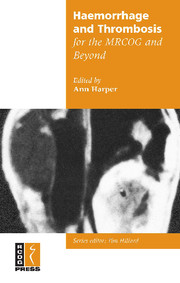Book contents
- Frontmatter
- Contents
- About the authors
- Abbreviations
- Preface
- 1 The coagulation system in pregnancy
- 2 Pregnancy in women with inherited bleeding disorders
- 3 Maternal and fetal thrombocytopenia
- 4 Massive obstetric haemorrhage
- 5 Disseminated intravascular coagulation
- 6 Gynaecological problems in women with bleeding disorders
- 7 Venous thromboembolism in obstetrics and gynaecology
- 8 Genetic thrombophilias and antiphospholipid antibodies
- Index
5 - Disseminated intravascular coagulation
Published online by Cambridge University Press: 05 October 2014
- Frontmatter
- Contents
- About the authors
- Abbreviations
- Preface
- 1 The coagulation system in pregnancy
- 2 Pregnancy in women with inherited bleeding disorders
- 3 Maternal and fetal thrombocytopenia
- 4 Massive obstetric haemorrhage
- 5 Disseminated intravascular coagulation
- 6 Gynaecological problems in women with bleeding disorders
- 7 Venous thromboembolism in obstetrics and gynaecology
- 8 Genetic thrombophilias and antiphospholipid antibodies
- Index
Summary
Disseminated intravascular coagulation (DIC) is not a disease or a symptom. It is a syndrome, characterised by a dynamic process of intravascular coagulation disseminated throughout the microcirculation resulting in thrombin generation and intravascular fibrin formation. Massive continuing activation of coagulation results in consumption of clotting factors and platelets. Thrombin generation is compounded by simultaneous depression of the natural anticoagulant mechanisms such as antithrombin and the thrombomodulin/protein C/protein S system. The process may be accompanied by secondary fibrinolysis or inhibition of fibrinolysis due to high circulating levels of plasminogen activator inhibitor-1.
DIC is an acquired disorder secondary to underlying pathology including a variety of obstetric complications. The clinical presentation is due to microthrombi generated in the microcirculation and consequent organ failure and/or a bleeding diathesis. There is no single test for DIC. Diagnosis depends on an awareness of the conditions which may be complicated by DIC combined with a variety of laboratory tests. The cornerstone of management of DIC is treatment of the underlying disorder.
Fibrin formation results from activation of the coagulation cascade. Normally, tissue factor, the physiological trigger for coagulation activation, is separated from the circulating blood by the endothelial cell barrier but, when this is disrupted by injury, tissue factor can bind with factors VII and VIIa, initiating coagulation via the extrinsic coagulation cascade and resulting in thrombin generation. The generation and activity of thrombin are tightly regulated by multiple natural anticoagulant pathways including antithrombin, thrombomodulin/protein C/protein S and tissue factor pathway inhibitor.
Keywords
- Type
- Chapter
- Information
- Haemorrhage and Thrombosis for the MRCOG and Beyond , pp. 59 - 71Publisher: Cambridge University PressPrint publication year: 2005



